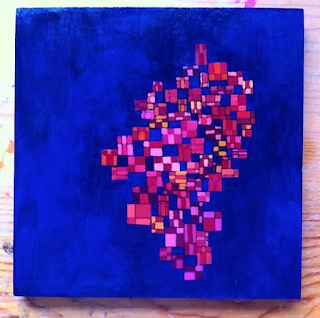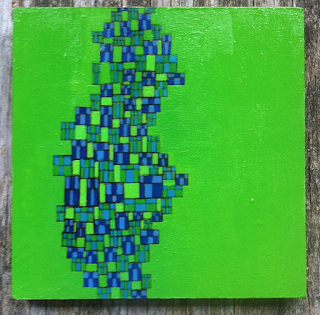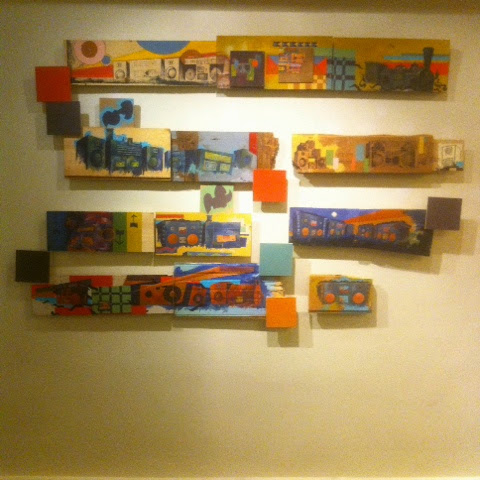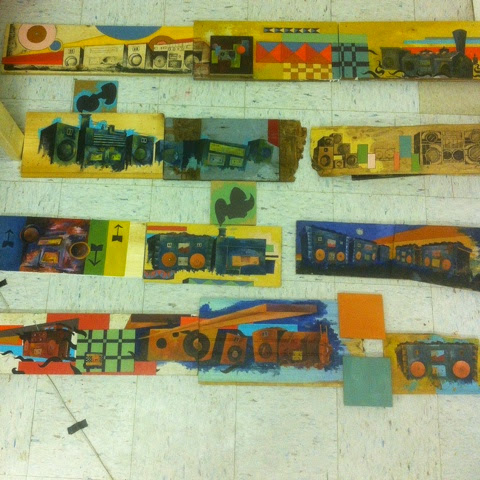Creating art with an audience seems at once both daunting and inspiring. Even the most casual visitor to the studio often breaks my concentration for hours. At the same time, I have long wanted to create a mural or some other piece of public art. I enjoy the idea of artwork that is immediately accessible to a broad audience and not simply limited to gallery visitors and the sadly endangered creatures we know as “art collectors.” I have had some limited experience with viewing my work in a public environment. In 2011, I participated in the Billboard Art Project in New Orleans. It was incredible seeing my work at that scale with the actual earth and sky as the backdrops to my representative imagery. That experience left me wanting for a more permanent experience, however. While I was able to see my artwork on a grand scale, I did not experience the process of painting in the midst of the public; creating under observation.
It was with great pleasure, then, to be approached my Meg Shorette, of Launchpad and Central Gallery, to participate in the Queen City Piano Project. Meg and her crew of volunteers placed 5 pianos in parks throughout Bangor, ME. Each piano was to be hand-painted and designed by a different artist. I immediately could see my random and spontaneous patterns working their way across the body of a piano. It seemed to me the best opportunity I had had thus far to paint on a piece of found material and to create in the public. Coupled with this excitement was also the fear of becoming some sort of natural history exhibit or feeling like an animal penned up on display in the zoo. I imagined greetings from the public a la Steve Irwin. “Well, look ‘ere, mate. I’s an a’tist in ‘is natu’al habitat. Let’s poke him, eh?”
I have always envisioned my favorite artists, like McGee and Jasper Johns to be impervious to an audience, capable of focusing on their artwork at all times, while conversing with visitors or not. Jackson Pollack seemed dependent on an audience while painting, to validate his creative act, his performance. Alternatively, I was reading a blog post by Janice Mason Steeves in which she claims that she needs a space to herself in order to create work of consequence and quotes one of my favorites, Franz Kafka, who apparently couldn’t bear an audience.
“You once said that you would like to sit beside me while I write. Listen, in that case I could not write at all. for writing means revealing oneself to excess; that utmost of self-revelation and surrender, in which a human being, when involved with others, would feel he was losing himself, and from which, therefore, he will always shrink as long as he is in his right mind…That is why one can never be alone enough when one writes, why there can never be enough silence around one when one writes, why even night is not night enough.”
In a blogpost on painting a hallway, writer, Paul Kleiman, talks about Stanislavski’s “Circle of Concentration,” the idea to choose your area of focus. He suggests that when you are painting you are able to reduce your area of focus to the spot right in front of you on your painting, noticing its irregularities and the movements of your brush only.
In truth, my studio practice is very much like this. It is all about solitude and the zen sensibility that a paint brush, palette and surface will elicit. It is about rhythm an motion and being in tune with the surface. I felt that this was a very private endeavor, but when I made it to Pierce Park to paint my piano, I found myself able to shrink my focus, to still create like I was in private. For all intents and purposes, I was by myself. I was unaware of the world around me but for the surface in front of me, but only using the idea of the “circle of concentration.”
I dove into my piano without a clear image of what I wanted it to look like in the end. I stuck with the locked box set of rules that I have been using in many of my patterns recently. The shapes of included in the patterns are all rectangles and vary only slightly within my locked box vernacular. The patterns grow spontaneously; one shape at a time in relation to the previous shapes. I was thinking about Thelonious Monk and Ahmad Jamal while drawing and painting this project, trying to solo using the limited locked box rules as jazz scales. The result seemed to be the most mature realization of the pattern making that I have experienced thus far.
I had relatively few visitors while finishing up the piano, but the people who did visit were interesting to talk with and seemed pleased to have a piece of public art available in the small city of Bangor. Due to my thoughts of jazz soloing, the experience seemed performative even when there was no one there. Ultimately, I found it compelling to create in an arena where people could see me working, enjoy the progress of the work, and take ownership of the process. I hope to create more work in the public sphere in the future. It felt as though the work was co-authored by the community that I was working in and that the work had a purpose to a wider audience.
Peace
-mike
















